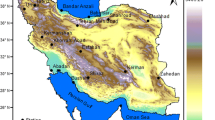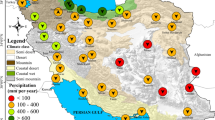Abstract
This study investigates the main characteristics (duration, severity, and trend) of meteorological drought events over Ankara Province, Turkey. We used 46 years of observed monthly precipitation and temperature series from six meteorological stations distributed across the study area to derive the well-known meteorological drought indices; the standardized precipitation index (SPI) and standardized precipitation evapotranspiration index (SPEI) both in 3-, 6-, and 12-month timescales. A comparative analysis between the indices, associated drought events, and potential trends at each station are presented. To explore the drought trends in each station, the well-documented Spearman rank-order correlation coefficient, innovative Şen’s method, and innovative trend analysis are applied. The results showed that the province faced five extreme drought events during the period of 1971–2016, although temporal inconsistencies between the SPI and SPEI, particularly in 6- and 12-month timescales exist. Considering the SPEI, the results indicated a slight descending trend in the observed drought events; however, the SPI does not conform to the same pattern.







Similar content being viewed by others
References
Abarghouei HB, Zarch MAA, Dastorani MT, Kousari MR, Zarch MS (2011) The survey of climatic drought trend in Iran. Stoch Env Res Risk A 25(6):851
Abbasi, A., Khalili, K., Behmanesh, J., & Shirzad, A. (2019). Drought monitoring and prediction using SPEI index and gene expression programming model in the west of Urmia Lake. Theoretical and Applied Climatology, 1-15
Adeloye AJ, Montaseri M (2002) Preliminary streamflow data analyses prior to water resources planning study/analyses préliminaires des données de débit en vue d'une étude de planification des ressources en eau. Hydrol Sci J 47(5):679–692
Ay M, Kisi O (2015) Investigation of trend analysis of monthly total precipitation by an innovative method. Theor Appl Climatol 120(3–4):617–629
Bacanli UG, Firat M, Dikbas F (2009) Adaptive neuro-fuzzy inference system for drought forecasting. Stoch Env Res Risk A 23(8):1143–1154
Caloiero T (2018) SPI trend analysis of New Zealand applying the ITA technique. Geosciences 8(3):101
Chattopadhyay S, Edwards D (2016) Long-term trend analysis of precipitation and air temperature for Kentucky, United States. Climate 4(1):10
Cui L, Wang L, Lai Z, Tian Q, Liu W, Li J (2017) Innovative trend analysis of annual and seasonal air temperature and rainfall in the Yangtze River basin, China during 1960–2015. J Atmos Sol Terr Phys 164:48–59
Dabanlı İ, Şen Z, Yeleğen MÖ, Şişman E, Selek B, Güçlü YS (2016) Trend assessment by the innovative-Şen method. Water Resour Manag 30(14):5193–5203
Danandeh Mehr A, Kahya E, Özger M (2014) A gene–wavelet model for long lead time drought forecasting. J Hydrol 517:691–699
Danandeh Mehr A, Sorman AU, Kahya E, Hesami Afshar M (2019) Climate change impacts on meteorological drought using SPI and SPEI: case study of Ankara Turkey. Hydrol Sci J. https://doi.org/10.1080/02626667.2019.1691218
Dong C, MacDonald GM, Willis K, Gillespie TW, Okin GS, Williams AP (2019) Vegetation responses to 2012–2016 drought in northern and Southern California. Geophys Res Lett 46(7):3810–3821
Eris E, Agiralioglu N (2012) Homogeneity and trend analysis of hydrometeorological data of the eastern Black Sea region, Turkey. J Water Resour Protect 4(02):99–105
Güçlü YS, Dabanlı İ, Şişman E, Şen Z (2019) Air quality (AQ) identification by innovative trend diagram and AQ index combinations in Istanbul megacity. Atmos Pollut Res 10(1):88–96
Hesami Afshar M, Sorman AU, Yilmaz MT (2016) Conditional copula-based spatial–temporal drought characteristics analysis—a case study over Turkey. Water 8(10):426
Jiang R et al (2015) Use of four drought indices for evaluating drought characteristics under climate change in Shaanxi, China: 1951–2012. Nat Hazards 75(3):2885–2903
Jin, X., Qiang, H., Zhao, L., Jiang, S., Cui, N., Cao, Y., & Feng, Y. (2019). SPEI-based analysis of spatio-temporal variation characteristics for annual and seasonal drought in the Zoige wetland, Southwest China from 1961 to 2016. Theoretical and Applied Climatology, 1-15
Labudová L, Labuda M, Takáč J (2017) Comparison of SPI and SPEI applicability for drought impact assessment on crop production in the Danubian lowland and the east Slovakian lowland. Theor Appl Climatol 128(1–2):491–506
McGhee JW (1985) Introductory statistics. West Publishing Co, New York
McKee, T.B., Doesken, N.J., and Kleist, J., (1993). The relationship of drought frequency and duration to time scales. In proceedings of the international 8th conference on applied climatology. American Meteorological Society, Anaheim, CA, USA, 17–22 January. Pp. 179–184
Meresa HK, Osuch M, Romanowicz R (2016) Hydro-meteorological drought projections into the 21-st century for selected polish catchments. Water 8(5):206
Montaseri M, Amirataee B (2017) Comprehensive stochastic assessment of meteorological drought indices. Int J Climatol 37(2):998–1013
Morid S, Smakhtin V, Moghaddasi M (2006) Comparison of seven meteorological indices for drought monitoring in Iran. Int J Climatol J Royal Meteorol Soc 26(7):971–985
Myronidis D et al (2018) Comparison of ten notable meteorological drought indices on tracking the effect of drought on streamflow. Hydrol Sci J 63(15–16):2005–2019
Nourani V, Danandeh Mehr A, Azad N (2018) Trend analysis of hydroclimatological variables in Urmia lake basin using hybrid wavelet Mann–Kendall and Şen tests. Environ Earth Sci 77(5):207
Partal T, Kahya E (2006) Trend analysis in Turkish precipitation data. Hydrol Process 20(9):2011–2026
Polong, F., Chen, H., Sun, S., & Ongoma, V. (2019). Temporal and spatial evolution of the standard precipitation evapotranspiration index (SPEI) in the Tana River basin, Kenya. Theoretical and Applied Climatology, 1-16
Rhee J, Im J (2017) Meteorological drought forecasting for ungauged areas based on machine learning: using long-range climate forecast and remote sensing data. Agric For Meteorol 237:105–122
Beguería S. & Vicente-Serrano, S.M. (2017) Precipitation-Evapotranspiration, SPEI: Calculation of the Standardised Index
Şen Z (2012) Innovative trend analysis methodology. J Hydrol Eng 17:1042–1046
Şen Z (2014) Trend identification simulation and application. J Hydrol Eng 19(3):635–642
Şen Z (2019) Partial trend identification by change-point successive average methodology (SAM). J Hydrol 571:288–299
Shiru M, Shahid S, Alias N, Chung ES (2018) Trend analysis of droughts during crop growing seasons of Nigeria. Sustainability 10(3):871
Sirdaş S, Sen Z (2003) Spatio-temporal drought analysis in the Trakya region, Turkey. Hydrol Sci J 48(5):809–820
Sönmez FK, Koemuescue AU, Erkan A, Turgu E (2005) An analysis of spatial and temporal dimension of drought vulnerability in Turkey using the standardized precipitation index. Nat Hazards 35(2):243–264
Tatli H, Türkeş M (2011) Empirical orthogonal function analysis of the Palmer drought indices. Agric For Meteorol 151(7):981–991
Türkeş M, Tatlı H (2009) Use of the standardized precipitation index (SPI) and a modified SPI for shaping the drought probabilities over Turkey. Int J Climatol: A J Royal Meteorolo Soc 29(15):2270–2282
Stagge JH et al (2015) Candidate distributions for climatological drought indices (SPI and SPEI). Int J Climatol 35(13):4027–4040
Terzi Ö, Taylan ED, Özcanoğlu O, Baykal T (2019) Drought estimation of Çanakkale with data mining. Düzce Üniversitesi Bilim ve Teknoloji Dergisi 7(1):124–135
Tosunoglu F, Can I, Kahya E (2018) Evaluation of spatial and temporal relationships between large-scale atmospheric oscillations and meteorological drought indexes in Turkey. Int J Climatol 38(12):4579–4596
Tosunoglu F, Kisi O (2017) Trend analysis of maximum hydrologic drought variables using Mann–Kendall and Şen's innovative trend method. River Res Appl 33(4):597–610
Vicente-Serrano SM, Beguería S, López-Moreno JI (2010) A multiscalar drought index sensitive to global warming: the standardized precipitation evapotranspiration index. J Clim 23(7):1696–1718
Wang Y, Liu G, Guo E (2019) Spatial distribution and temporal variation of drought in Inner Mongolia during 1901–2014 using standardized precipitation evapotranspiration index. Sci Total Environ 654:850–862
Wu H, Qian H (2017) Innovative trend analysis of annual and seasonal rainfall and extreme values in Shaanxi, China, since the 1950s. Int J Climatol 37(5):2582–2592
Xu ZX, Takeuchi K, Ishidaira H (2003) Monotonic trend and step changes in Japanese precipitation. J Hydrol 279(1–4):144–150
Yacoub E, Tayfur G (2017) Evaluation and assessment of meteorological drought by different methods in Trarza region, Mauritania. Water Resour Manag 31(3):825–845
Yang, M., Yan, D., Yu, Y., and Yang, Z. (2016). SPEI-based spatiotemporal analysis of drought in Haihe River Basin from 1961 to 2010. Adv Meteorol, 2016
Yihdego Y, Vaheddoost B, Al-Weshah RA (2019) Drought indices and indicators revisited. Arab J Geosci 12(3):69
Acknowledgments
We would like to thank the Turkish General Directorate of Meteorology (MGM) for providing the database used in this study.
Author information
Authors and Affiliations
Corresponding author
Additional information
Publisher’s note
Springer Nature remains neutral with regard to jurisdictional claims in published maps and institutional affiliations.
Rights and permissions
About this article
Cite this article
Danandeh Mehr, A., Vaheddoost, B. Identification of the trends associated with the SPI and SPEI indices across Ankara, Turkey. Theor Appl Climatol 139, 1531–1542 (2020). https://doi.org/10.1007/s00704-019-03071-9
Received:
Accepted:
Published:
Issue Date:
DOI: https://doi.org/10.1007/s00704-019-03071-9




